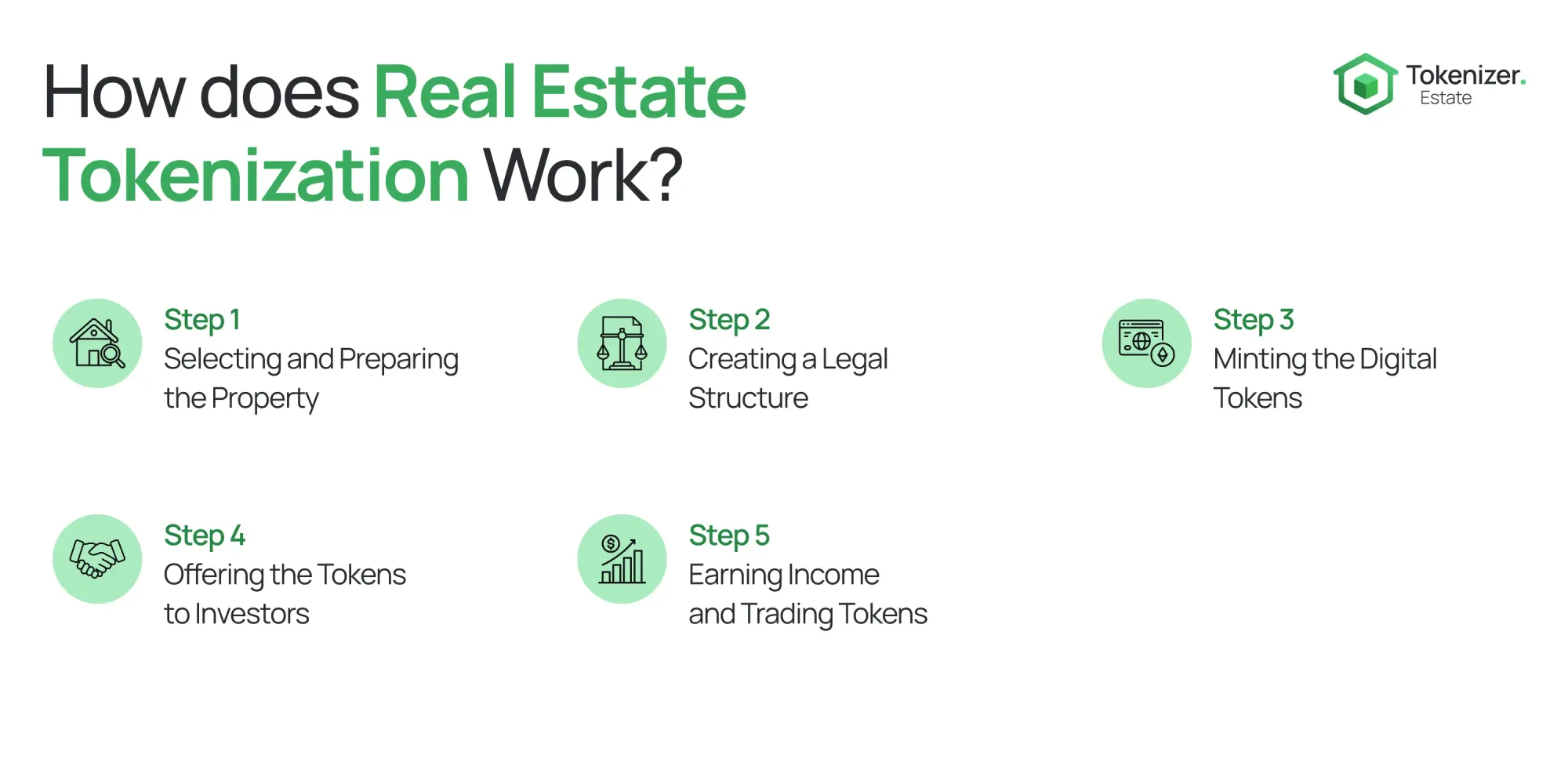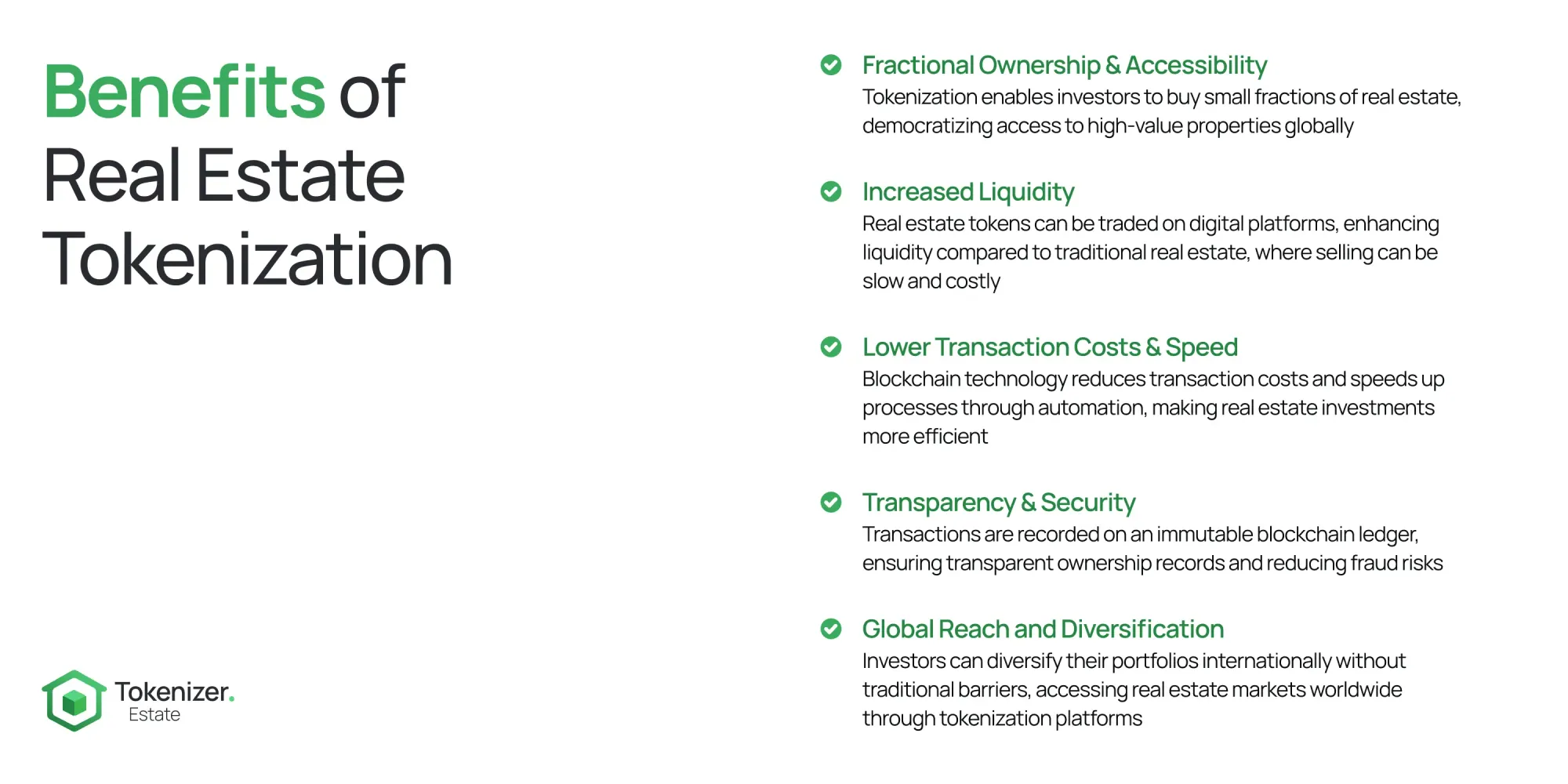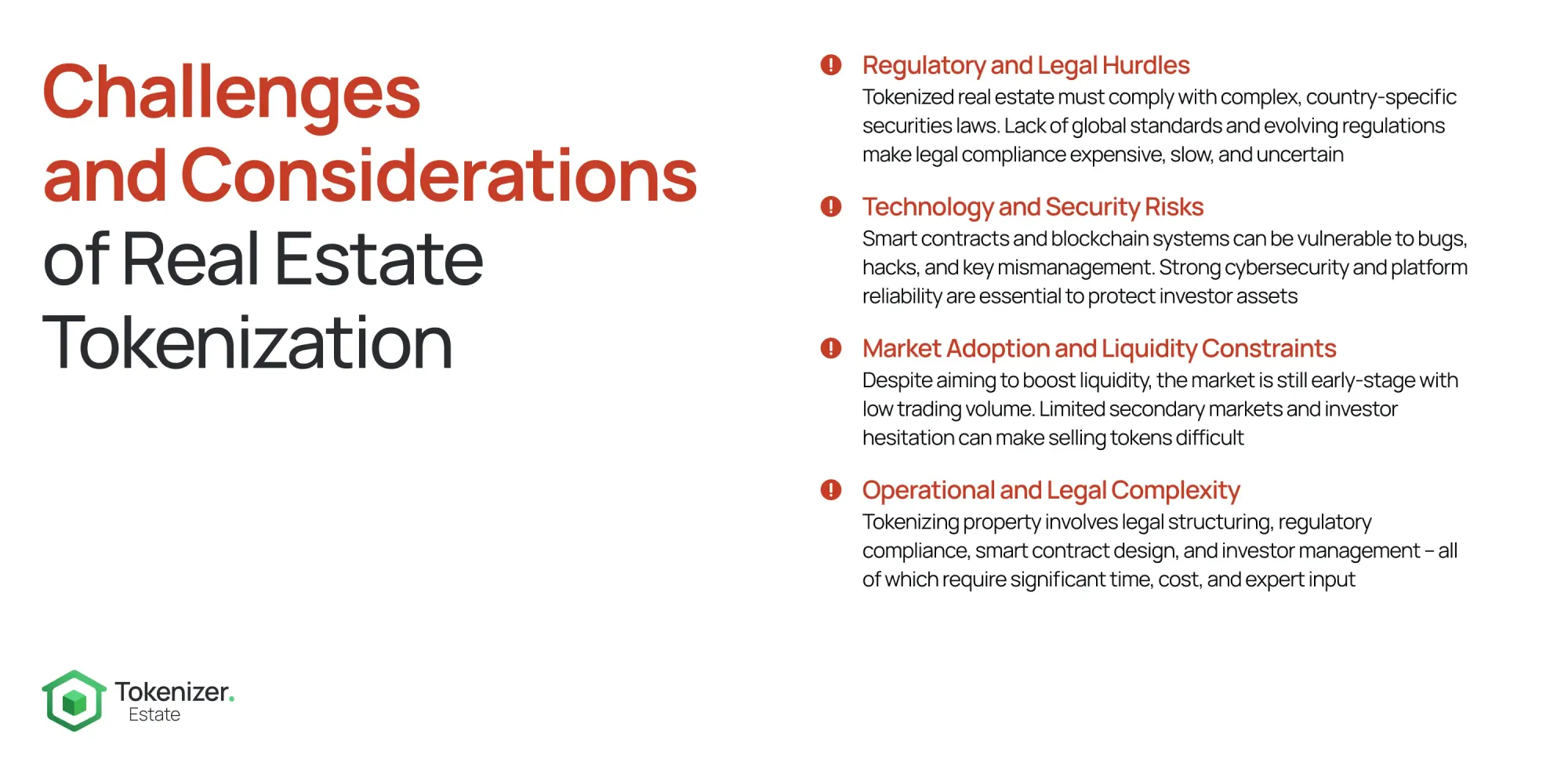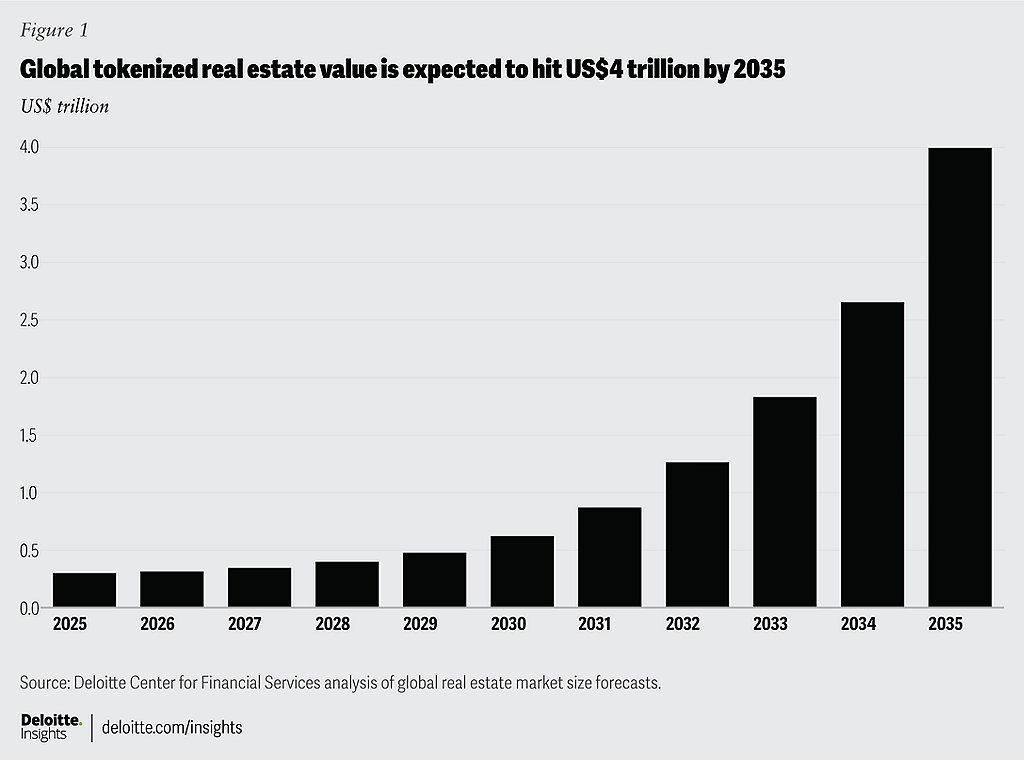Real Estate Tokenization

Imagine being able to invest in a slice of a premium skyscraper with just pocket change. This isn’t science fiction – it’s the promise of real estate tokenization, a trend that is redefining who can invest in property and how. Real estate tokenization essentially converts property value or ownership rights into digital tokens on a blockchain, letting people buy and trade fractions of buildings as easily as stocks. In mid-2025, this concept surged from theory to practice worldwide, with startups, government agencies, and institutional investors tokenizing everything from single apartments to multi-billion-dollar property portfolios. The result? Investing in real estate is becoming faster, more accessible, and more transparent than ever before.
What Is Real Estate Tokenization?
Real estate tokenization is the process of turning a real estate asset (or its income stream) into digital tokens that live on a blockchain. Each token represents a share of the property’s value or ownership. In practical terms, this means a building can be fractionalized into many small pieces, allowing investors to purchase, say, 1% of a building instead of having to buy the whole thing. These tokens are typically structured as security tokens, meaning they are regulated like stocks or bonds and confer legal rights (such as ownership or a share of rental income) to their holders. By representing property ownership in this digital form, tokenization increases liquidity, streamlines transactions, and enables digital ownership of real estate assets.
Importantly, tokenized real estate does not eliminate the traditional legal and financial structures – it augments them. Usually, the property is placed into a legal entity (like an LLC or special purpose vehicle), and then tokens are issued to represent shares in that entity. Investors who buy these tokens effectively become shareholders entitled to a portion of the property’s value and sometimes its income. Unlike REITs (Real Estate Investment Trusts) or crowdfunding, tokenization leverages blockchain technology to securely record ownership and trades. Every token transaction is logged on an immutable ledger, providing a transparent trail of who owns what. In short, real estate tokenization blends the stability of property with the flexibility of digital securities.
How is this different from traditional real estate investment? In a word: accessibility. Tokenization allows for fractional ownership, greater liquidity, and lower barriers to entry than buying properties outright. Traditionally, investing in real estate required significant capital and involved slow, paper-heavy transactions. By contrast, tokenized real estate can let someone invest with as little as tens or hundreds of dollars, and tokens can potentially be traded instantly on digital marketplaces, rather than waiting months to sell an entire property. This democratization means more people can participate in real estate investing and diversify their portfolios beyond stocks and bonds. Next, we’ll look at how the tokenization process actually works from start to finish.
How Does Real Estate Tokenization Work?

Tokenizing a property involves several key steps, combining traditional real estate processes with blockchain technology. Below is an overview of how a physical building becomes a digital token that anyone can invest in:
Selecting and Preparing the Property
Every tokenization journey begins with a real, tangible property. It might be an office building in New York, a rental apartment in Berlin, or a villa in Bali. The property owner (often called the “sponsor”) chooses a property that is valuable and likely to generate income (e.g. through rent). Due diligence is crucial at this stage – lawyers verify the title is clear, taxes are paid, and the building meets all legal requirements. Only when the property is free of legal issues can it move to the next step.
Creating a Legal Structure
You generally cannot tokenize a property directly in someone’s name. Instead, the owner sets up a legal entity (such as a limited company or a Special Purpose Vehicle) to hold the property. This entity is what actually issues the digital tokens. Essentially, the tokens represent shares in the company that owns the real estate.
By doing this, the structure stays compliant with property laws and investment regulations. Each token gives its holder a small ownership stake in the property (through the company) – and often rights to a portion of any rental income or profits. In other words, if you hold tokens, you’re a partial owner, similar to being a shareholder in a property-owning company. Because these tokens typically qualify as securities, the project must follow securities laws (investor disclosures, reporting, etc.) just like a stock offering.
Minting the Digital Tokens
Next comes the blockchain component. The company (via a technology provider or platform) creates a smart contract on a blockchain network (common choices are Ethereum, Polygon, or specialized security token blockchains). This smart contract is basically a self-executing program that defines the token’s properties – how many tokens will exist in total, what each token represents, and the rules for transferring tokens.
Creating the tokens on the blockchain is called “minting.” For example, a building worth $10 million might be represented by 1,000,000 tokens, each token representing a $10 stake. Once minted, these tokens are recorded on the blockchain ledger. At this point, the tokens are like a digital certificate of ownership in the property-holding entity. However, before they can be sold, regulatory compliance is double-checked – ensuring the token issuance abides by financial regulations in the relevant jurisdiction.
Offering the Tokens to Investors
The sale of the tokens is usually done through a regulated sale known as a Security Token Offering (STO) or similar offering. During this phase, investors (individuals or institutions) can sign up on the tokenization platform or portal. They will typically go through KYC (Know Your Customer) and AML checks to verify identity and eligibility, since laws require verifying investors for security offerings. Once cleared, investors are able to purchase the tokens. This can often be done with traditional money (e.g. bank transfer or credit card) and sometimes with cryptocurrency.
The entry amounts are usually much lower than buying a property outright – in many tokenized offerings, minimum investments can be as low as $50 or $100. For instance, instead of needing $100,000 to invest in a rental property, someone might buy $100 worth of tokens. The initial sale distributes the tokens to all the new co-owners in proportion to their investment.
Earning Income and Trading Tokens
Once the property is tokenized and investors hold the tokens, business continues as usual in the real world – if the property generates rent or income, investors are entitled to their share. A modern twist is that these payments can be automated; for example, rental income can be converted into stablecoins (like USDC) and distributed directly to token holders’ digital wallets regularly.
Beyond income, investors aren’t locked in indefinitely – they can trade their tokens on secondary markets or exchanges that support security tokens. In contrast to traditional real estate (where selling even a small portion of a property could take months of paperwork), token holders might sell any amount of their stake within minutes on a compliant trading platform. This new liquidity means an investor could exit their real estate investment much faster than before. Platforms such as RealT, for example, offer marketplaces where people buy and sell fractional tokens of rental properties, making real estate a far more liquid asset class.
Throughout this process, blockchain technology underpins trust and efficiency. The blockchain ledger records every token transaction, creating a transparent and tamper-resistant history of ownership. Smart contracts automate many steps (like distributing income or enforcing transfer restrictions), which reduces the need for middlemen and can cut down on transaction costs. However, it’s worth noting that compliance and legal oversight are still essential – tokenized real estate deals involve lawyers, regulators, and platform operators working together to ensure everything is done by the book. When done right, tokenization can turn a once illiquid, high-barrier asset into something as easy to manage as an online investment account.
Benefits of Real Estate Tokenization

Real estate tokenization is gaining buzz because it addresses some of the biggest pain points in traditional property investing. Here are the key benefits driving its appeal:
- Fractional Ownership & Accessibility
Tokenization democratizes access to real estate. Instead of needing huge capital to buy an entire property, investors can buy small fractions. This means a college student or a first-time investor could put $100 into a high-end office building or a luxury hotel token and gain exposure to that asset’s gains. By lowering the minimum investment, tokenized real estate opens the market to a much broader audience of investors than ever before. Even globally, someone sitting in Asia could invest in a tokenized office tower in New York, breaking down geographic barriers in real estate investing.
- Increased Liquidity
Liquidity refers to how easily an asset can be bought or sold for cash. Traditional real estate is notoriously illiquid – selling property can take months and significant transaction costs. Tokenization changes that by enabling trading on digital platforms. Investors can sell their tokens on secondary markets without having to sell the whole underlying property. This means if you need cash, you could liquidate a portion of your real estate investment quickly. As one industry report noted, tokenizing property “opens real estate to a broader audience” and improves liquidity in a market that’s historically been slow. In essence, real estate starts to behave a bit more like stocks – an asset you can trade when you choose, rather than being locked in for years.
- Lower Transaction Costs & Speed
By utilizing blockchain and smart contracts, tokenization can make transactions faster and cheaper. Middlemen like brokers, escrow agents, and lots of paperwork are reduced, which cuts down fees. KPMG observes that tokenization significantly reduces the time and cost involved in fractional real estate investment and subsequent trading of shares. Smart contracts automate compliance checks and transaction settlement, so what normally takes weeks (or months) in a property sale can potentially be done in days or hours. This efficiency not only saves money but also makes the investment process more convenient for investors and sellers alike.
- Transparency & Security
Every token transaction is recorded on an immutable blockchain ledger, providing a transparent record of ownership. This transparency builds trust – an investor can independently verify that their ownership is recorded and see the history of the asset. The blockchain’s security (through cryptography and decentralized consensus) means records are extremely tamper-resistant. It’s very difficult for anyone to falsify ownership or “double-sell” a token. As a result, the risk of fraud can be reduced. In fact, blockchain’s transparent ledger “significantly reduces the risk of fraud and minimizes errors” in real estate deals. All parties can trust that the data on ownership and transactions is accurate and up-to-date. Moreover, smart contracts enforce rules automatically (for example, preventing an unverified investor from purchasing tokens), adding another layer of security to the process.
- Global Reach and Diversification
Tokenization platforms on the internet allow investors from around the world to participate (subject to regulatory restrictions). A person in Europe can invest in tokenized properties in America or Asia with a few clicks, and vice versa. This global reach means developers and property owners can tap into a worldwide investor pool, potentially raising capital faster and at better valuations. For investors, it means the opportunity to diversify their real estate holdings internationally without the usual complexities of cross-border transactions. You could own a fraction of an apartment building in Tokyo, a piece of a London office block, and a share of a Dubai shopping center, all through one online portfolio. Such diversification can help spread risk and access growth in different real estate markets.
In summary, tokenization makes real estate more accessible, more liquid, and more efficient. It takes an old, illiquid asset class and gives it the flexibility of digital finance, while retaining the tangible value of bricks-and-mortar property. These benefits don’t come without challenges, however. Next, we’ll consider some of the hurdles that real estate tokenization must overcome as it matures.
Challenges and Considerations

While real estate tokenization is promising, it’s not a magic solution – there are significant challenges and risks to be aware of:
- Regulatory and Legal Hurdles
Property laws and securities regulations vary widely across countries, and tokenized assets often fall under strict securities law compliance. Projects must navigate regulations like securities registration, KYC/AML, and investor qualification rules. The legal status of a digital token representing real estate can be complex – regulators want to ensure investor protection and prevent illegal activities. There’s also a lack of global standards: a tokenized offering might be legal in one country but not recognized in another. This regulatory uncertainty means tokenization initiatives often proceed cautiously, and in some cases offerings are limited to accredited (high-net-worth) investors to stay within exemptions. Until laws fully catch up, legal compliance remains a major effort and cost in any tokenization project.
- Technology and Security Risks
Tokenization introduces tech components that carry their own risks. Blockchain systems and smart contracts, while secure by design, can be vulnerable to bugs or hacks. If a smart contract is poorly coded, it might be exploited by attackers. There’s also the issue of digital asset custody – investors need to manage digital wallets and private keys safely. Losing access to your private key could mean losing your tokenized asset ownership. Platforms must implement strong cybersecurity measures to protect against hacks of token exchanges or wallet breaches. Additionally, the reliance on a particular blockchain platform means if that network has outages or issues, the asset could temporarily become untradeable. These technological risks mean due diligence is needed on the platform’s security and backup measures. The good news is that over time, best practices (audited contracts, insured custody solutions, etc.) are emerging to mitigate these risks.
- Market Adoption and Liquidity Constraints
Ironically, while tokenization is meant to improve liquidity, in practice the market is still young. Many tokenized real estate offerings are new with limited secondary market activity. Investors might find that there aren’t always buyers ready when they want to sell their tokens, especially in early stages of a project. Building a vibrant marketplace for trading these tokens will take time and participation. Moreover, traditional investors and institutions may be cautious – awareness and understanding of tokenized assets is still growing. It will take education and some success stories to build trust among mainstream investors.
Another consideration is price discovery: with low trading volume, the market price of a token might not always reflect the true underlying property value, potentially leading to volatility. Over time, as more investors join and platforms mature, these liquidity and adoption issues should improve. But currently, tokenized real estate is not as widely traded as stocks or traditional REITs, meaning investors should be prepared for lower liquidity until the market matures.
- Operational and Legal Complexity
Tokenizing a property isn’t as simple as pressing a button. Setting up the legal structure, integrating with blockchain, complying with regulations, and managing an investor community all add complexity (and cost). There are also legal questions still being ironed out – for example, how to handle disputes or changes (like a property sale or redevelopment) when thousands of token holders are involved. Smart contracts cover many scenarios but not everything in the real world can be automated. Projects must have contingency plans and possibly legal provisions off-chain to handle unforeseen events. Additionally, factors like how to value a token (property appraisal vs. market trading price) require careful consideration so that token holders have confidence in what they’re buying. These complexities mean that professional advice (legal, financial, tech) is essential in any tokenization project, and they represent a barrier to entry for some property owners.
Despite these challenges, the momentum behind real estate tokenization continues to build. Each year brings clearer regulatory frameworks and more robust technology solutions. For instance, some countries have launched regulatory sandboxes to support tokenized asset trials, and major firms are developing insured custody and trading platforms specifically for real estate tokens. The industry is learning quickly from early projects, addressing issues around compliance, security, and market structure. In the next section, we’ll look at some real-world examples that show how these challenges are being met in practice – and how tokenization is already changing the real estate landscape.
Real-World Examples of Tokenized Real Estate
Real estate tokenization has moved beyond theory, with live projects across the globe demonstrating its potential. Here are a few notable examples that illustrate how tokenization works in practice:
The St. Regis Aspen Resort in Colorado was among the first high-profile tokenized properties. In 2018, the hotel’s owners sold nearly 19% of the property as digital tokens, raising over $18 million from investors worldwide. This landmark project showed that luxury real estate could be fractionalized and sold to multiple investors via blockchain. Buyers of the Aspen tokens could participate in the hotel’s ownership without the massive capital typically needed for such an asset. The minimum investment was $10,000, a far cry from the tens of millions the whole hotel was worth. This pioneering case gave a preview of how tokenization can unlock equity in high-end properties and attracted significant attention in the real estate and tech communities.
Tokenization isn’t limited to niche experiments; it’s gaining traction in major markets. Dubai, for example, has embraced tokenized real estate at a government level. In 2025, Dubai’s Land Department launched a platform to put property shares on blockchain, aiming to digitize a portion of the city’s multibillion-dollar property market. Through this initiative (called Prypco Mint), investors – initially in the UAE, and eventually abroad – can buy fractional pieces of Dubai properties with a minimum investment around $540 (2,000 AED). This project, backed by regulators and local banks, illustrates a city leveraging tokenization to broaden access to its booming real estate sector. Neighboring Saudi Arabia followed suit by piloting its first tokenized property offering, enabling Saudi citizens to invest in high-end real estate for as little as a few dollars. Officials there called it a “paradigm shift,” noting it was the first time someone could invest in a premium skyscraper with just pocket change.
In the United States, tokenization has shown its value in commercial real estate. In 2024, a U.S. asset manager tokenized a $5.4 million office building in Florida, selling fractional tokens to investors who now earn roughly 5% annual rental yields from the property. These tokens trade on a digital marketplace, meaning investors can liquidate their stake or even borrow against it as easily as any other digital asset. This example demonstrated not only the viability of tokenization for income-producing assets but also how liquidity in commercial real estate can be enhanced through DeFi (decentralized finance) platforms.
Meanwhile, traditional finance hubs like Japan have also successfully implemented tokenized real estate within regulatory frameworks. A notable case is the 2024 launch of “Kolet-1” by Kenedix, a large Japanese real estate firm, in partnership with Nomura Bank. Kolet-1 was a token representing a portfolio of 462 rental homes valued around $130 million. What made this project special is that it was offered through a conventional bank channel and was open to everyday retail investors, not just institutions. The offering raised over $63 million and provides token holders with quarterly rental income distributions. Japan’s clear regulation in this space allowed a seamless blending of blockchain and traditional investment – showing that tokenized real estate can go fully mainstream when handled by trusted institutions.
These examples barely scratch the surface. From Europe to Africa, dozens of platforms and projects are bringing property assets online. A Deloitte report noted that since the first tokenized real estate deals in 2017-2018, tokenization has opened new avenues for property investment and could build trillions of dollars of economic activity in the coming decade. In Canada, for instance, companies have launched large tokenized property funds under existing securities laws, proving that even $50+ million deals can be done on-chain within current regulations. The momentum is undeniable: tokenized real estate is live and growing, with tokens trading and investors (big and small) participating in deals that used to be off-limits to them.
The Future of Real Estate Tokenization

Real estate tokenization is still an emerging trend, but all signs point to it becoming a significant part of the property market’s future. Analysts predict rapid growth as technology and regulations evolve. For example, Deloitte forecasts that roughly $4 trillion of real estate could be tokenized by 2035, up from less than $300 billion in 2024 – an astounding compound growth rate of about 27% per year. This growth would be fueled by wider adoption of tokenization in everything from commercial real estate funds to loans and even land registries.
One reason for this optimism is that tokenization offers solutions to long-standing industry issues. It can help real estate firms overcome high operational costs and limited retail participation by unlocking new markets and products. As more success stories emerge (like the ones we discussed), confidence in tokenized assets is likely to increase. We’re also seeing improvements in the ecosystem: specialized blockchain platforms for real estate, better legal frameworks, and involvement from established financial institutions all signal that tokenization is moving into the mainstream.
That said, the transformation will be gradual. Regulators around the world are catching up – many are now actively updating laws to accommodate digital assets and ensure investor protection in tokenized offerings. Industry groups and governments are working on standards for how tokens can represent real-world assets in a legally recognized way. This regulatory clarity is crucial for tokenization to flourish on a larger scale. Market education is another piece: as investors become more familiar with the concept and see it in action (perhaps in their retirement accounts or through fintech apps), tokenized real estate will gain trust and popularity.
Crucially, tokenization is not about replacing traditional real estate – it’s about upgrading it. The bricks-and-mortar nature of real estate isn’t going away, but the way we invest in and manage it is evolving. By combining real-world assets with digital technology, we can create a more inclusive and efficient market without losing the stability that real estate provides. As one expert succinctly put it, tokenization is no longer just an idea; it’s a working system – with live platforms, traded tokens, and real returns.
In the coming years, we can expect tokenized real estate to become a normal part of global finance. Imagine buying a few tokens of a new apartment development in another country as easily as you’d buy shares in a company, or cities updating property records to blockchain to cut red tape. Early adopters are already experiencing these changes, and their successes are paving the way for broader adoption. The future of real estate investment is likely to be more fractional, digital, and borderless. Real estate tokenization, with its ability to empower investors and streamline transactions, is at the forefront of this exciting transformation.
Ultimately, real estate tokenization promises to bridge the gap between the physical value of properties and the agility of modern financial markets. If the current trends continue, the question may shift from “Why tokenize real estate?” to “Why not?” – as owning and trading slices of properties could become as common as using a smartphone to hail a ride. The revolution in real estate investing is underway, and it’s bringing the benefits of blockchain to an asset class that has long been ripe for innovation.
Stay informed.
Subscribe to blog.tokenizer.estate for expert insights, real-world case studies, and the latest updates in real estate tokenization 🏠

